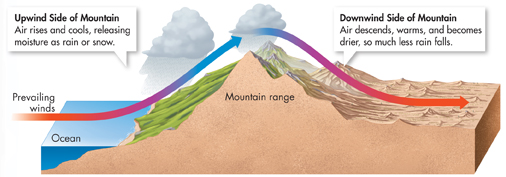4.4 Biomes
 What abiotic and biotic factors characterize biomes?
What abiotic and biotic factors characterize biomes? What areas are not easily classified into a major biome?
What areas are not easily classified into a major biome?
canopy • understory • deciduous • coniferous • humus • taiga • permafrost
Preview Visuals Before you read, preview Figure 4–18. Write down the names of the different biomes. As you read, examine the photographs and list the main characteristics of each biome.
THINK ABOUT IT Why does the character of biological communities vary from one place to another? Why, for example, do temperate rain forests grow in the Pacific Northwest while areas to the east of the Rocky Mountains are much drier? How do similar conditions shape ecosystems elsewhere?
The Major Biomes
 What abiotic and biotic factors characterize biomes?
What abiotic and biotic factors characterize biomes?
In Lesson 1, you learned that latitude and the heat transported by winds are two factors that affect global climate. But Oregon, Montana, and Vermont have different climates and biological communities, even though those states are at similar latitudes and are all affected by prevailing winds that blow from west to east. Why? The reason is because other factors, among them an area's proximity to an ocean or mountain range, can influence climate.
Regional Climates Oregon, for example, borders the Pacific Ocean. Cold ocean currents that flow from north to south have the effect of making summers in the region cool relative to other places at the same latitude. Similarly, moist air carried by winds traveling west to east is pushed upward when it hits the Rocky Mountains. This air expands and cools, causing the moisture in the air to condense and form clouds. The clouds drop rain or snow, mainly on the upwind side of the mountains—the side that faces the winds, as seen in Figure 4–16. West and east Oregon, then, have very different regional climates, and different climates mean different plant and animal communities.

FIGURE 4–16 The Effect of Coastal Mountains As moist ocean air rises over the upwind side of coastal mountains, it condenses, cools, and drops precipitation. As the air sinks on the downwind side of the mountain, it expands, warms, and absorbs moisture.
ddTable of Contents
- Formulas and Equations
- Applying Formulas and Equations
- Mean, Median, and Mode
- Estimation
- Using Measurements in Calculations
- Effects of Measurement Errors
- Accuracy
- Precision
- Comparing Accuracy and Precision
- Significant Figures
- Calculating With Significant Figures
- Scientific Notation
- Calculating With Scientific Notation
- Dimensional Analysis
- Applying Dimensional Analysis




